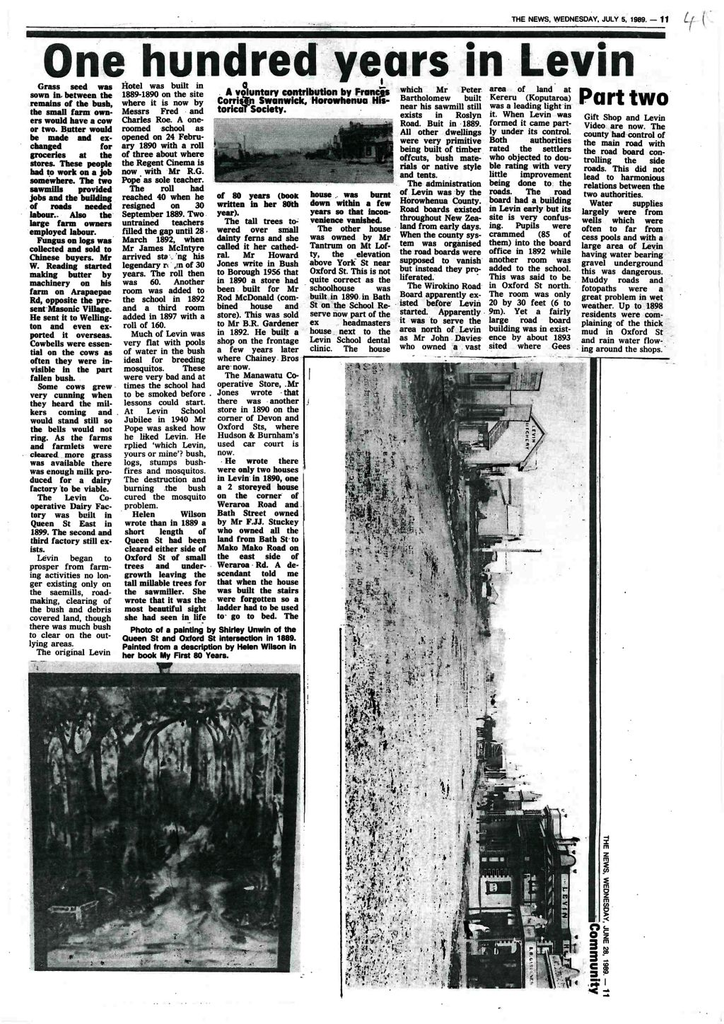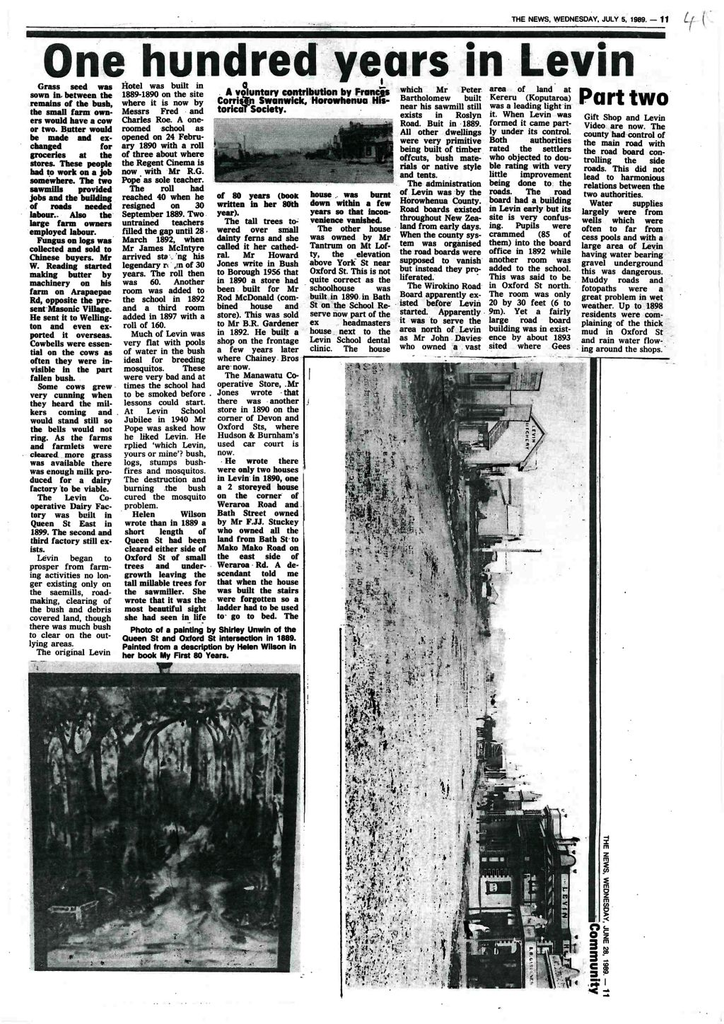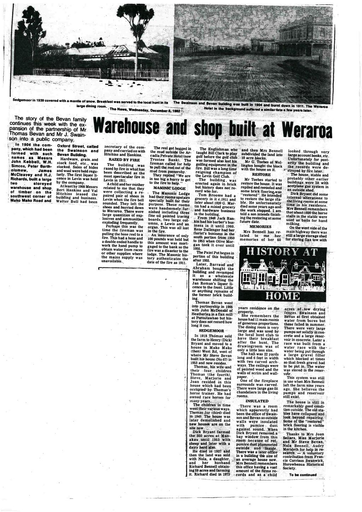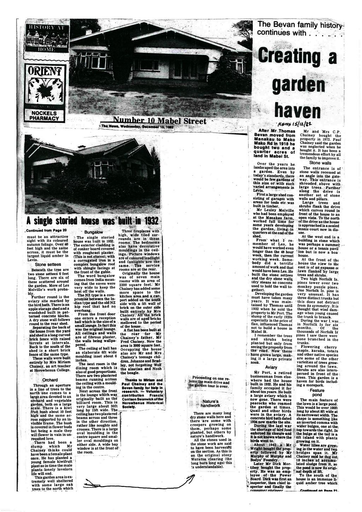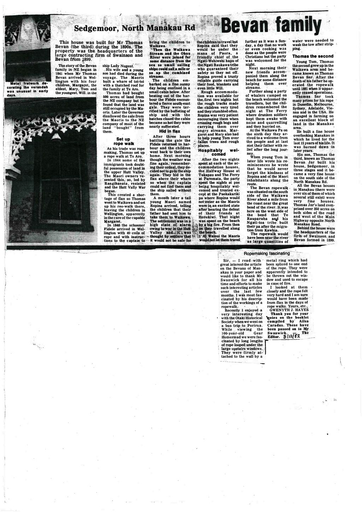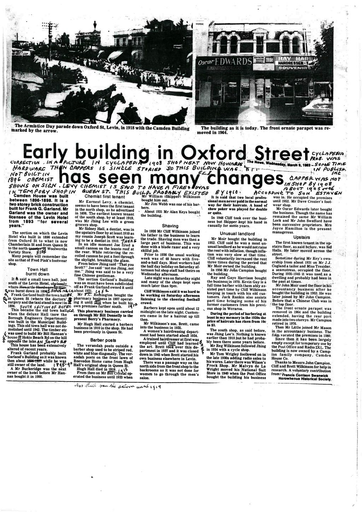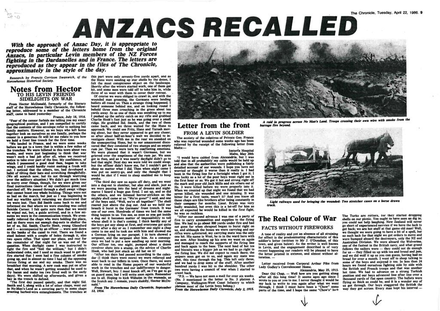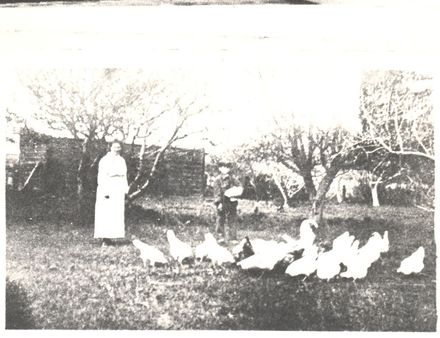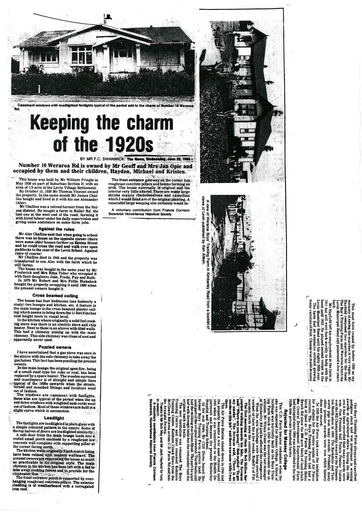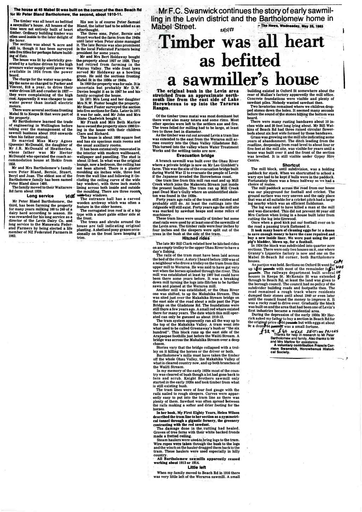One Hundred Years in Levin - Part Two
- Description
Fungus on logs was collected and sold to Chinese buyers. Mr W. Reading started making butter by machinery on his farm on Arapaepae Rd, opposite the present Masonic Village. He sent it to Wellington and even exported it overseas. Cowbells were essential on the cows as often they were invisible in the part fallen bush.
Some cows grew very cunning when they heard the milkers coming and would stand still so the bells would not ring. As the farms and farmlets were cleared more grass was available, so there was enough milk produced for a dairy factory to be viable.
The Levin Cooperative Dairy Factory was built in Queen St East in 1899. The second and third factory still exist.
Levin began to prosper from farming activities no longer existing only on the sawmills, road making, clearing of the bush and debris covered land, though there was much bush to clear on the outlying areas.
The original Levin Hotel was built in 1889-1890 on the site where it is now, by Messrs Fred and Charles Roe.
Photo on left shows Oxford Street Levin, taken from north of the Oxford Street / Queen Street intersection looking south c . 1890. The road is unsealed and narrows at what is now the Oxford Street / Bath Street intersection. A small cottage is on this site. In the distance in Weraroa is a large two storied building, possibly the “Weraroa Hotel”. The Levin Hotel is the large building on the southern corner of Oxford Street and Queen Street West.
A one-roomed school was opened on 24 February 1890 with a roll of three about where the Regent Cinema is now with Mr R.G. Pope as sole teacher.
The roll had reached 40 when he resigned on 30 September 1889. Two untrained teachers filled the gap until 28 March 1892, when Mr James McIntyre arrived starting his legendary reign of 30 years. The roll then was 60. Another room was added to the school in 1892 and a third room added in 1897 with a roll of 160.
Much of Levin was very flat with pools of water in the bush, ideal for breeding mosquitoes. These were very bad and at times the school had to be smoked before lessons could start. At Levin School Jubilee in 1940 Mr Pope was asked how he liked Levin. He replied ‘which Levin, yours or mine’? Bush, logs, stumps, bushfires and mosquitoes. The destruction and burning the bush cured the mosquito problem.
Helen Wilson wrote than in 1889 a short length of Queen St had been cleared either side of Oxford St of small trees and undergrowth leaving the tall millable trees for the sawmiller. She wrote that it was the most beautiful sight she had seen in life of 80 years (book written in her 80th year).
The tall trees towered over small dainty ferns and she called it her cathedral. Mr Howard Jones wrote in Bush to Borough 1956 that in 1890 a store had been built for Mr Rod McDonald (combined house and store). This was sold to Mr B.R. Gardener in 1892. He built a shop on the frontage a few years later where Chainey Bros are now.
The Manawatu Cooperative Store, Mr Jones wrote that there was another store in 1890 on the corner of Devon and Oxford Sts, where Hudson & Burnham’s used car court is now.
He wrote there were only two houses in Levin in 1890, one a 2 storied house on the corner of Weraroa Road and Bath Street owned by Mr F.J Stuckey who owned all the land from Bath St to Mako Mako Road on the east side of Weraroa Rd. A descendant told me that when the house was built the stairs were forgotten, so a ladder had to be used to go to bed. The house was burnt down within a few years so that inconvenience vanished.
The other house was owned by Mr Tantrum on Mt Lofty, the elevation above York St near Oxford St. This is not quite correct as the schoolhouse was built in 1890 in Bath St on the School Reserve now part of the ex headmasters house next to the Levin School dental clinic. The house which Mr Peter Bartholomew built near his sawmill still exists in Roslyn Road, built in 1889. All other dwellings were very primitive being built of timber offcuts, bush materials, or native style and tents.
The administration of Levin was by the Horowhenua County. Road Boards existed throughout New Zealand from early days. When the county system was organised the road boards were supposed to vanish but instead they proliferated.
The Whirokino Road Board apparently existed before Levin started. Apparently it was to serve the area north of Levin as Mr John Davies who owned a vast area of land at Kereru (Koputaroa) was a leading light in it. When Levin was formed it came partly under its control. Both authorities rated the settlers who objected to double rating with very little improvement being done to the roads. The road board had a building in Levin early but its site is very confusing. Pupils were crammed (85 of them) into the board office in 1892 while another room was added to the school. This was said to be in Oxford St north. The room was only 20 by 30 feet (6 to 9m). Yet a fairly large road board building was in existence by about 1893 sited where Gees Gift Shop and Levin Video are now. The county had control of the main road with the road board controlling the side roads. This did not lead to harmonious relations between the two authorities.
Water supplies largely were from wells which were often not too far from cess pools and with a large area of Levin having water bearing gravel underground this was dangerous. Muddy roads and footpaths were a great problem in wet weather. Up to 1898 residents were complaining of the thick mud in Oxford St and rain water flowing around the shops.
THE NEWS, WEDNESDAY, JUNE 28, 1989.
Identification
- Date
- June 28, 1989
Taxonomy
- Community Tags

